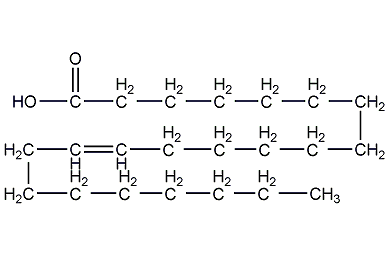Erucic acid Erucic acid


Structural formula
| Business number | 036T |
|---|---|
| Molecular formula | C22H42O2 |
| Molecular weight | 338.57 |
| label |
cis-13-docosenoic acid; C22 unsaturated fatty acid, Cis-13-II dodecyl acid, C22 unsaturated fatty acids, Surfactant, lubricants, plasticizer, emulsifier, softener, waterproofing agent, Detergent |
Numbering system
CAS number:112-86-7
MDL number:MFCD00063188
EINECS number:204-011-3
RTECS number:JR1280000
BRN number:1728049
PubChem number:24894510
Physical property data
1. Properties: White needle-like crystals
2. Density (g/mL, 55℃): 0.86
3. Relative vapor density (g/mL, air =1): Undetermined
4. Melting point (ºC): 28-34
5. Boiling point (ºC, normal pressure): 281 (decomposition)
6. Boiling point (ºC, 2.0KPa): 265
7. Refractive index (45 ºC): 1.4534
8. Flash point (ºC): >110
9. Specific optical rotation (º): Undetermined
10. Autoignition point or ignition temperature (ºC): Undetermined
11. Vapor pressure (mmHg,ºC ): Undetermined
12. Saturated vapor pressure (kPa, ºC): Undetermined
13. Heat of combustion (KJ/mol): Undetermined
14. Critical temperature (ºC): Undetermined
15. Critical pressure (KPa): Undetermined
16. Log value of oil-water (octanol/water) partition coefficient: Undetermined Determined
17. Explosion upper limit (%, V/V): Undetermined
18. Explosion lower limit (%, V/V): Undetermined
19. Solubility: Easily soluble in ether, ethanol and methanol, insoluble in water.
20. Freezing point (ºC): 31-33
Toxicological data
None
Ecological data
Molecular structure data
1. Molar refractive index: 105.59
2. Molar volume (cm3/mol): 379.9
3. Isotonic specific volume (90.2K ): 916.4
4. Surface tension (dyne/cm): 33.8
5. Polarizability (10-24cm3): 41.86
Compute chemical data
1. Hydrophobic parameter calculation reference value (XlogP): 8.7
2. Number of hydrogen bond donors: 1
3. Number of hydrogen bond acceptors: 2
4. Number of rotatable chemical bonds: 19
5. Number of tautomers:
6. Topological molecular polar surface area (TPSA): 37.3
7. Number of heavy atoms: 24
8. Surface charge: 0
9. Complexity: 284
10. Number of isotope atoms: 0
11. Determine the number of atomic stereocenters: 0
12. Uncertain number of atomic stereocenters: 0
13. Determine the number of chemical bond stereocenters Number: 1
14. Number of uncertain chemical bond stereocenters: 0
15. Number of covalent bond units: 1
Properties and stability
1. Avoid contact with oxides. White needle-like crystals, easily soluble in ether, ethanol and methanol, but insoluble in water.
2. Erucic acid is a slightly yellow crystalline waxy solid at room temperature. Erucic acid is the monomer acid with the longest carbon chain currently used in large-scale industry. The amide made from behenic acid is heat-resistant. It is easily miscible with organic resins at high temperatures, and easily precipitates on the resin surface when cooled. This product is non-toxic.
Storage method
1. Packed in 200L/barrel coated with PVF or in 20m3 ISO stainless steel container tanks. Store in a cool, ventilated and dry place, away from fire sources and prevent moisture.
Synthesis method
1. Using rapeseed oil or oily bottoms as raw materials, use traditional methods (saponification and acidolysis; acidification hydrolysis or pressure hydrolysis) to hydrolyze rapeseed oil fatty acids, and then separate erucic acid from the rapeseed oil fatty acids. The mixed fatty acids are frozen, pressed, and after preliminary separation, purer erucic acid can be obtained by vacuum distillation.
2.Mustard oil and erucic acid are obtained from mustard seeds through fermentation and distillation, and then separated and purified.
Purpose
1. The biggest use of erucic acid is to produce erucic acid amide. This product is smooth and has good processing characteristics, which is obviously better than other low-carbon chains. Amide. Erucic acid and behenic acid and their derivatives obtained after hydrogenation are also widely used, including the preparation of surfactants, detergents, plastics and their additives, photographic and recording materials, food additives, cosmetics, pharmaceuticals, personal protective equipment, Ink additives, paper, textiles, lubricants and fuel additives, etc.
2.Used to prepare various surfactants, cosmetics, Chemical fiber oils, etc.